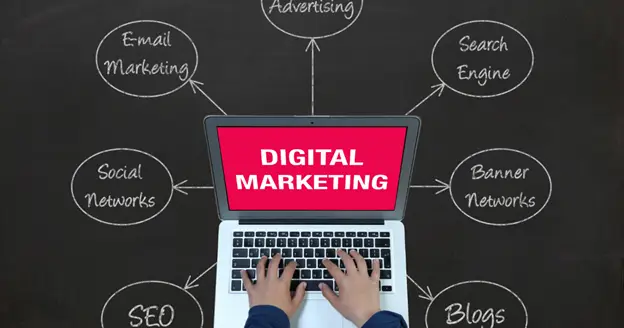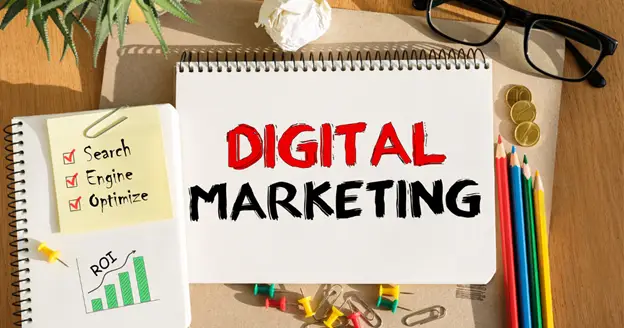Learn how to build a winning digital marketing strategy for small business in 10 clear steps. Get found, grow sales, and keep your marketing simple and smart.
If you’re a small business owner trying to grow online, you’ve probably heard all the buzzwords, funnels, SEO, paid ads, email campaigns…
It can feel like a lot. And half the time, you’re stuck asking, “Where do I even start?”
That’s why I wrote this post, to help you build a clear, no-fluff digital marketing strategy for small business that works even if you’re not a marketing expert.
Why Every Small Business Needs a Digital Strategy (Even a Tiny One)
Here’s the deal: People search online before they buy. Whether it’s pizza or plumbing or personalized T-shirts, folks are Googling it first.
So, if your business isn’t showing up online, or if your message is confusing, you’re handing customers to your competition.
But when you have a digital marketing strategy that’s clear, simple, and built for your business? That’s when things click.
Let’s break it down.
Step 1: Get Clear on Who You’re Talking To
You don’t need to target everyone. You just need to be super clear about who your ideal customer is.
Ask yourself:
- What problem are they trying to solve?
- What keeps them stuck?
- Where do they hang out online (Instagram, Google, YouTube)?
- Create a simple customer profile. Give them a name. The clearer you are here, the easier everything else becomes.
Step 2: Clean Up Your Website (or Set One Up)
Your website doesn’t need to be fancy. But it does need to:
- Load fast
- Look good on mobile
- Tell people exactly what you offer
- Make it easy to take the next step (call, book, buy)
If you’re starting from scratch, platforms like Squarespace, WordPress, or Shopify can get you online fast.
Bonus tip: Add clear buttons that say things like “Book Now” or “Get a Quote.” Don’t leave folks guessing.
Step 3: Claim and Optimize Your Google Business Profile
If you run any kind of local business (salon, clinic, food service, etc.), this step is a goldmine.
- Head to Google Business Profile (formerly Google My Business)
- Claim or create your listing
- Add photos, your services, business hours, and contact info
- Ask happy customers to leave reviews
This helps you show up in local search and on Google Maps, especially when people search “near me.”
Step 4: Start Small with Social Media
Don’t try to be everywhere. Pick one or two platforms where your audience actually spends time.
- If you sell visual products: Instagram or Pinterest
- If you’re B2B or a coach: LinkedIn
- If you’re local or community-based: Facebook or TikTok
Post helpful, real content, not just promos. Behind-the-scenes clips, tips, mini tutorials, client stories… those things build trust and make people remember you.

Step 5: Use Email Marketing (Yes, Even if You’re New)
Email might feel old-school, but it still works, and it gives you a direct line to your audience.
Start with:
- A simple lead magnet (freebie, discount, checklist)
- A signup form on your website or social media
- An email tool like MailerLite, ConvertKit, or Mailchimp
Once you’ve got subscribers, send weekly or bi-weekly emails with tips, updates, or promos. Keep it conversational.
Step 6: Create Helpful, Searchable Content
This is where SEO comes in, but don’t worry, it’s not as scary as it sounds.
Start by:
- Writing blog posts that answer your customers’ questions
- Using keywords they might type into Google (like “how to fix a clogged sink” or “best skincare for oily skin”)
- Optimizing your titles, headers, and meta descriptions
Not only does this help you get found on Google, it also shows your audience you know your stuff.
Step 7: Set a Realistic Budget for Paid Ads
You don’t have to dump thousands into ads to see results. Start small.
- Try Facebook or Instagram ads to promote a product or freebie
- Use Google Ads for local services or in-demand products
- Track your results so you know what’s working
Only scale when you’ve tested and seen a return.
Step 8: Automate the Repetitive Stuff
As your business grows, so will your to-do list. The good news? A lot of digital marketing can be automated.
Here’s what to automate first:
- Welcome emails or nurture sequences
- Social media scheduling (try Buffer or Later)
- Booking confirmations or reminders
- FAQs with a chatbot
Automation saves you time and keeps your customers engaged even when you’re offline.
Step 9: Build Partnerships and Collaborations
Sometimes, the best strategy is to team up.
Find complementary businesses in your niche and:
- Do Instagram Lives together
- Co-host a giveaway
- Swap guest blog posts
- Feature each other in newsletters
This helps you reach new people without spending money on ads.
Step 10: Track What’s Working (and What’s Not)
This is the step most people skip, but it’s what makes or breaks a digital marketing strategy for small business.
Use basic tools like:
- Google Analytics (for website traffic)
- Email open & click rates
- Social post engagement
- Sales or inquiry conversions
Look at your numbers every month. Double down on what’s working. Ditch what isn’t. Keep it lean and simple.

Final Thoughts
You don’t need a huge team or fancy tech to succeed online.
You just need a plan that fits your size, your audience, and your schedule. That’s what a smart digital marketing strategy for small business is all about.
Start small. Stay consistent. Adjust as you grow.
And most importantly, don’t try to do everything at once. Pick two or three steps above, do them well, and build from there.
You’ve got this.





